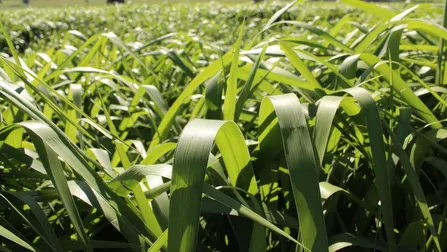Indicação
É indicada para solos mal drenados e de média a baixa fertilidade, sendo assim uma boa opção para substituir a Humidicola nestas áreas. Comparada a Humidícola, possui a vantagem de apresentar melhor qualidade nutricional e as sementes não apresentarem dormência. É recomendada para bovinos nas fases de cria, recria e engorda, e também para equinos.
Setaria sphacelata cv. MG11 Tijuca
Certificado n° 20140106 até 08.12.2028
Média a baixa fertilidade
Pastoreio direto
10 a 12 t/ha/ano de MS
7,9 a 8,7%
Até 1,65 m
51 a 53%
Muito Boa
Muito boa
Muito boa
Perene
Utilização e Manejo
A MG11 Tijuca é uma pastagem indicada para solos de média a baixa fertilidade, e mal drenados. Por ser tolerante a solos com umidade excessiva, vem substituído com vantagens a Humidícola em regiões pantaneiras pois suas sementes não apresentam dormência, garantindo assim um estabelecimento de pastagem mais rápido, e por possuir uma melhor qualidade nutricional. É recomendada para bovinos nas fases de cria, recria e engorda. Pode ser utilizada também para equinos, recomendando-se sempre fazer uma suplementação mineral adequada. A entrada de pastejo da MG11 Tijuca em sistema rotacionado deve ocorrer com plantas de 60 a 70 cm, e a saída na altura de 20 cm do solo.
Características Morfológicas
A cultivar MG11 Tijuca é uma gramínea tetraplóide, de ciclo perene, planta entouceirada de crescimento ereto, altura em torno de 1,65m, com folhas de coloração verde-azulada, folhas com mais de 30 cm de comprimento e mais de 1,0 cm de largura, colmo fino com 0,38 cm de diâmetro. A planta possui bom desenvolvimento do sistema radicular e presença de rizomas.
Origem
Matsuda Genética. Essa cultivar foi originária de cruzamentos de diversos acessos de Setaria sphacelata originários da Matsuda Genética e posterior seleção (trata-se de uma população híbrida obtida pelo método de policross). Os cruzamentos tiveram início em 2004 e a seleção de plantas com boa produção de forragem, maior quantidade de folhas e porte mais baixo, características superiores à cultivar Kazungula, comercializada há anos.






